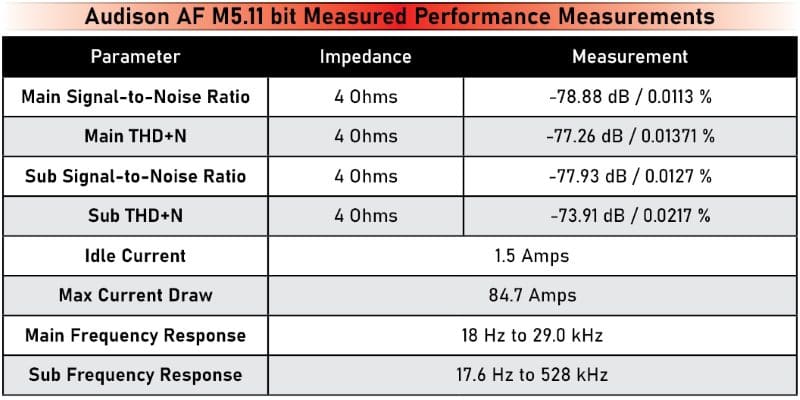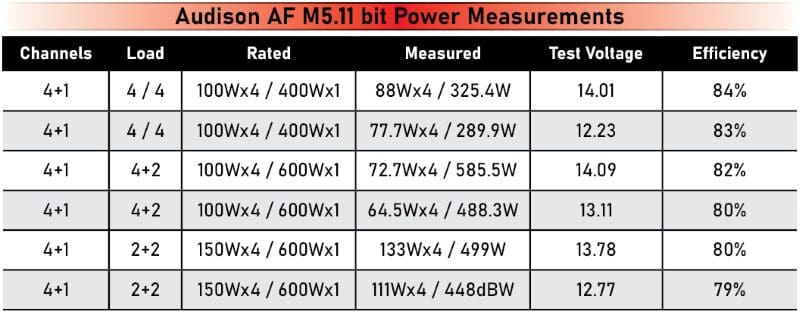Audison is well known in the car audio industry for its bit series of car audio signal processors. From the introduction of the fabled bit ONE back in 2008 to the impressive Prima series multichannel amps and the fantastic bit ONE HD Virtuoso, Audison has been at the forefront of these performance-improving technologies for as long as any brand and longer than most. If you’ve followed their timeline, you know that Audison initially launched four-, five- and eight-channel DSP-equipped amplifiers in the Prima series, then added the more powerful eight-channel Forza model for those who wanted their systems to play louder.
In 2022, Audison launched a new product group called Forza, which includes five DSP-equipped amplifiers, two multichannel amps without processing and a 1,200-watt monoblock to give your subwoofers a workout. In this Test Drive Review, we’ll look at the Forza AF M5.11 bit five-channel DSP-equipped amp.
Audison AF M5.11 bit Specifications
Let’s start by looking at the basic physical platform of the AF M5.11 bit. This compact five-channel amp is based on a cast-aluminum heatsink that measures a diminutive 9.44 by 6.14 inches and is only 1.85 inches tall. All the connections are made along the front edge of the amp, and there are no controls or switches on the chassis other than for the Automatic Remote Turn On/Off selector. The left side of the heatsink has a cutout for the pair of ATC-style 30-amp fuses. Finally, there’s a removable panel on the right side of the amp for optional modules we’ll discuss later.
The amplifier has four main channels, each of which is rated to produce 100 watts of power into 4 ohms or 150 watts into 2 ohms. The CTA-2006-C compliant power rating is specified as 85 watts per channel into 4 ohms. Each pair of channels can also be bridged to provide 300 watts of power to a 4-ohm load. The subwoofer channel is rated for 400 watts into a 4-ohm load and an impressive 600 watts into a 2-ohm driver. The CTA spec for the subwoofer channel is 340 watts. Audison specifies the amp as having a 10 Hz to 42 kHz audio bandwidth and a CTA-2006-C compliant signal-to-noise ratio of 78 dBA at 1 watt of output.
The amplifier has eight RCA inputs, each of which can accept up to 6 volts RMS of signal. There are also eight speaker-level input connections that will take up to 22 volts. The speaker-level inputs include Audison’s Universal Speaker Simulator circuitry to present an appropriate load to the source amplifier providing the signal. Your installer can add four additional speaker-level inputs by installing the optional F4IN module on the side of the chassis. The AF M5.11 bit also features a S/PDIF input that will handle 24-bit, 192-kHz stereo audio signals. The optional F20 card adds a digital input and includes an optical and coaxial digital connection, should your system design require it. The amp can only accept a single accessory card at a time.
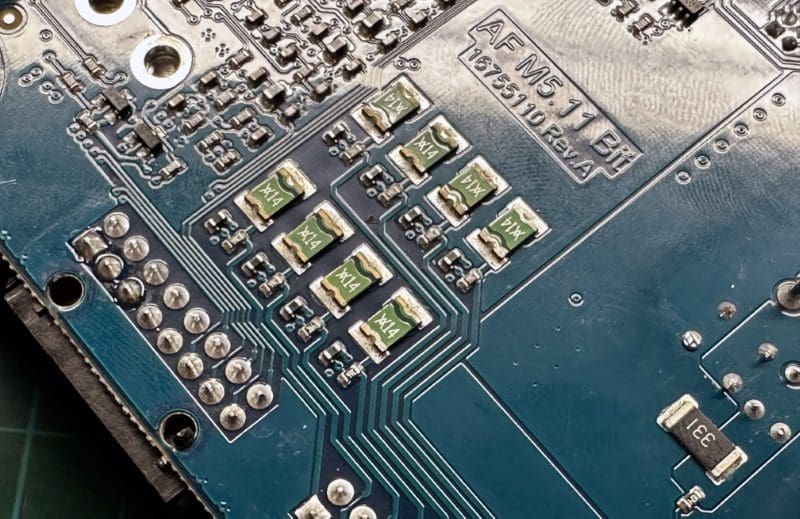
Amplifier Layout and Features
The main side panel of any good DSP amplifier is a busy place. Power connections are handled by a large terminal block on the far left of the side panel. The block can easily accept four-AWG power and ground cables. With a maximum power output near 900 watts, you’ll want to use something like the Audison Connection Sonus-level MP 4 BL.2 and MP 4 G.2 wiring to ensure efficient power delivery.
Moving right from the power block, we find a small four-position Molex connector for the remote input and output connections, along with two control wires. The function of these wires can be configured in the bit Drive software to execute commands like a source change, preset change or volume change or to toggle the final tuning EQ.
The next two connections are speaker outputs with a pair of 18 AWG wires for each of the four main outputs and 14 AWG wire outputs for the subwoofer connections. The subwoofer output has two positive and two negative wires. Audison suggests using both pair of wires, even if the amp is driving a single 2-ohm subwoofer. Using both wires improves power delivery by reducing resistance. A 16-position plug provides connections to up to eight speaker-level inputs, and another 16-position plug has eight RCA input jacks for the pre-amp input plug.
The second row of connections starts on the right with a jack for the optional DRC remote control like the DRC AC. Audison notes that the Forza series uses a locking Molex connector, which is different from previous models to ensure a reliable connection. The TOSLINK jack is next and, as mentioned, accepts two-channel signals from a digital source. A 12-position plug handles the six channels of preamp-level outputs from the DSP. The provided connector on this sample has unterminated wires, but future units will have RCA jacks on the ends. Your installer can connect these signals to one of the non-DSP-equipped Forza amplifiers (using the optional AF LINK cable) that includes the appropriate Molex connections.
The following connection is for an optional iDatalink Maestro AR integration module. This jack accepts digital commands from the interface that have been extracted from the CAN network in the vehicle. In short, if there’s an AR solution for your car or truck, the AF M5.11 bit can mimic the factory-installed amplifier’s volume, fading and tone control functions while providing complete flexibility in system design and configuration. In addition, I’m told the new interface is lighting-fast, so there are effectively no perceivable delays between radio adjustments and amplifier response.
The next four-position plug is labeled ADC and is designed to work with the B-CON Bluetooth interface. This connection allows the B-CON to transmit a full bit-depth digital signal to the amp, then adjust the output volume digitally to optimize performance. To read more about the B-CON, check our Test Drive Review from March 2022. I understand that this feature isn’t fully implemented in the current software (when we published this review), so ask your retailer to check with their Audison distributor about implementing this feature.
Second-to-last is a micro-USB port provided so that your installer can connect the amplifier to a laptop computer to configure the system. Last is the switch mentioned above for the Automatic Remote Turn On/Off functionality. The switch has a third position labeled Upgrade. This function would only be required under rare conditions where an update failed, as might happen if power were interrupted during an update process. I performed a firmware upgrade during the time I had the amp in the lab, and the process was smooth and uneventful. I didn’t have to press buttons or move switches.

Removing the bottom panel of the amp shows the back of the main circuit board. With so many features, it’s no surprise that both sides of the circuit board are full of surface-mount devices. Removing the circuit board from the cast-aluminum heatsink shows that Audison put some serious effort into optimizing the thermal management features of the chassis. Several aluminum protrusions extend up from the casting to wick heat away from the power supply and output switching devices. The board is clamped securely to these surfaces, and thermally conductive tape is used to help keep things cool. A secondary board in the corner is home to the system’s digital signal processing. Audison uses an Analog Devices ADAU1467 SigmaDSP to handle audio signal mixing, routing and processing.
The circuit board is well organized and full of high-quality components. On the input side, the amp has eight 1,000-microfarad, 35-volt caps and a large ceramic core inductor to keep switching noise from feeding back along the power cables. The supply’s output has eight 1,000-microfarad 50-volt caps for energy storage. The output switching devices are all surface-mount MOSFETs. As mentioned, these devices touch a protrusion from the heatsink to help keep them cool. The bottom panel of the amp includes spring-loaded pressure pads to improve heat transfer and prevent buzzes and rattles. Mechanically, this would have been a VERY complex amplifier to design. It’s pretty impressive!
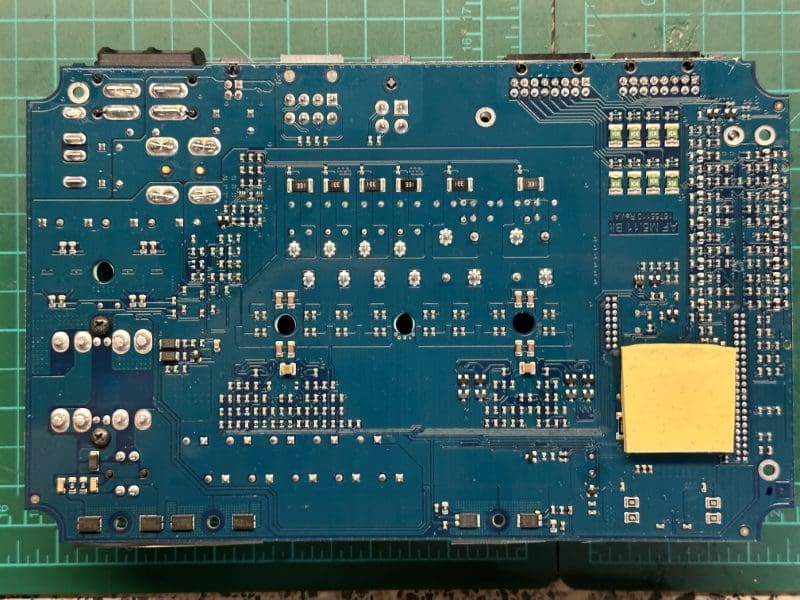

A dual power supply design is another important and interesting feature of the AF M5.11 bit. The amp has a typical, loosely regulated high-current supply that feeds that audio output circuitry. For this supply, the output voltage is proportional to the supply voltage. A second power supply feeds the DSP board and its supporting electronics. This low-voltage supply is stiffly regulated so that the amp won’t shut down, and more importantly, the DSP and CPU won’t crash or hang if the supply voltage drops during a supply voltage dip from a vehicle stop/start sequence.
I’m told the audio path also has a few unique design features. The Class D control ICs used in this amp are similar to those used in other high-end solutions. However, rather than stick with the manufacturer’s reference design, Audison has dramatically increased the switching frequency. This decision moves the switching noise away from the audible range. Lastly, Audison uses a fourth-order filter on the outputs instead of the typical second-order suggested by the reference design. This added filtering further reduces radio frequency noise. Many companies claim to design their products in-house, yet in most cases, they use reference designs from component suppliers. It’s nice to see a company doing things that take time and engineering knowledge to improve performance and add value.
Digital Signal Processing Features
If you’ve been following Audison over the last few years, you know that integrating audio upgrades with factory-installed premium audio systems is at the top of their goal list. This is a lofty challenge, as these systems are incredibly complex. From dealing with simple active filtering and signal delays to intricate designs with upmixers, all-pass filters and dynamic equalization, the chance of a car audio retailer being able to guarantee that an upgrade will sound better than the original system has become very challenging.
Audison is approaching this challenge head-on by integrating powerful input-side signal processing features into their new bit processors and the Forza amplifiers. When used with the Audison bit Tune processor, a technician can measure everything required to understand how to create a time-coherent signal with a flat frequency response from which to build the system. Once this foundation is established, the installer can work on configuring and calibrating the system for your new speakers.
The integrated bit processor allows your installer to mix signals from any input to any processing channel. They can choose from Butterworth, Linkwitz-Riley, Bessel, Chebychev or QLP filter alignments in slopes from 6 to 48 dB per octave. Unlike some processors, -48 dB filter attenuation is available in bandpass mode, should it be required. Each output channel has 15 bands of parametric equalization available with a boost/cut range of plus or minus 12 dB and Q-factors from 0.5 to 16. Any of the filters can be switched to a high or low shelf, a notch filter or a first- or second-order all-pass filter. Delays are adjustable in 0.01-millisecond steps, and output levels can be decreased in 0.5-dB steps.
Audison has integrated an acoustic real-time analyzer that can be fed from almost any USB microphone connected to your laptop. The RTA can also analyze the electrical signal from a source unit or amplifier. The response graph includes the option to display a target curve on the screen to make manual calibration easier for your technician. Currently, three target curves are included in the bit Drive suite, but more are being developed, and a curve editor is also in the works. Once the individual speaker adjustments are complete, the tech can access a five-band parametric “final tuning” equalizer that makes it easy to tweak the systems to a listener’s preferences without altering the soundstage or focus characteristics.
So, as luck would have it, I was just about finished with this review when the folks at Audison released version 1.0 of their bit Drive software. This meant I had to go back and reword some content and add a few tests to the mix. A few critical points about bit Drive 1.0 first. The latest software and the accompanying firmware for the Forza series amplifiers include automated De-EQ and De-Time correction and input signal polarity confirmation. Of course, these features aren’t a concern if you use an aftermarket source unit. However, they could be a lifesaver if you plan to use a factory-installed audio system with speaker-level connections. Guessing what’s happening to the signal from even a modest source unit is risky. If your installer isn’t measuring every channel for amplitude, phase and delay, the results might not be to your liking.
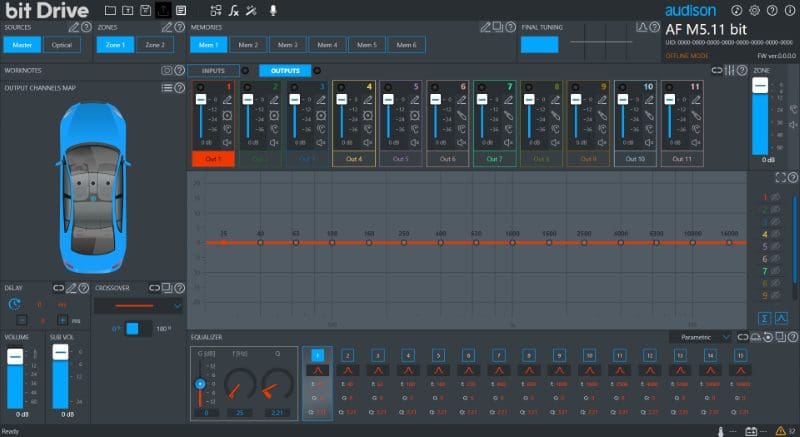
Audison Forza Amplifier Listening Evaluation
I installed the bit Drive software on my laptop and configured channels one and two with Linkwitz-Riley 24 dB/octave high-pass filters at 80 hertz and the subwoofer channel with a matching low-pass filter. Channels one and two fed my bookshelf speakers, and the subwoofer channel drove a 10-inch subwoofer in a vented enclosure from a previous review. Next, I adjusted the output levels to hit the listening room’s target acoustic response curve. Once set and Finalized (Audison’s term for storing the settings to the processor in the amp), it was time to play some music.
I was impressed by the high-frequency performance of the Forza five-channel. Some would use words like open and airy to describe what I heard. Ultimately, the amp was passing high-frequency signals without attenuation or significant distortion. I was listening to Norah Jones’s “Come Away with Me.” The cymbals’ ring and the metal brushes’ detail were very lifelike. The amp reproduced a realistic sense of depth – something I haven’t heard in a while. There was a slight emphasis in the lower midrange region of her voice, but it wasn’t significant.
I listened to Billie Eilish’s “Come Out and Play” next. Her voice and the percussion were locked dead-center of the soundstage. The crunchy synthesized percussion panned hard left and right without issue. The bass was well-controlled and had good extension. If you go through the entire album, you’ll notice lots of subtle details in the backgrounds of certain songs. These include pops and clicks from what’s supposed to be a vinyl record and conversations way back in the distance. They all seemed very real when amplified by the Audison AF M5.11 bit.
The last track I played was “Your Latest Trick” by Dire Straits. The lead horn was clear and brassy, and there was a nice ring to the cymbal on the left. The guitar was placed solidly left of center. The drums were big and perhaps a touch more present than would be deemed authentic – but that’s a result of the low-frequency boost in my target curve and not the amplifier.
This amplifier sounded excellent and had no problem playing softly or at high volumes that shook the ceiling tiles in the room. Furthermore, it turned on and off without any noise. In all, very impressive!
Lab Testing the Audison AF M5.11 bit
The last step in reviewing this amp was to set it up in the lab again, zero out all the DSP settings and make some measurements. I started with frequency response sweeps of each channel to find the amplifier’s upper and lower roll-off limits. The first chart you’ll see below is the frequency response of one of the main channels when driving a 4-ohm load, a 2-ohm load and my simulated reactive load. The second chart shows the same three measurements for the subwoofer channel.
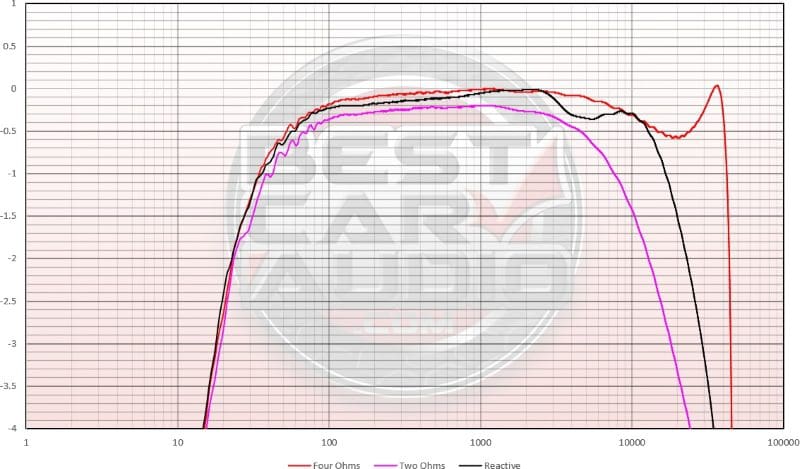
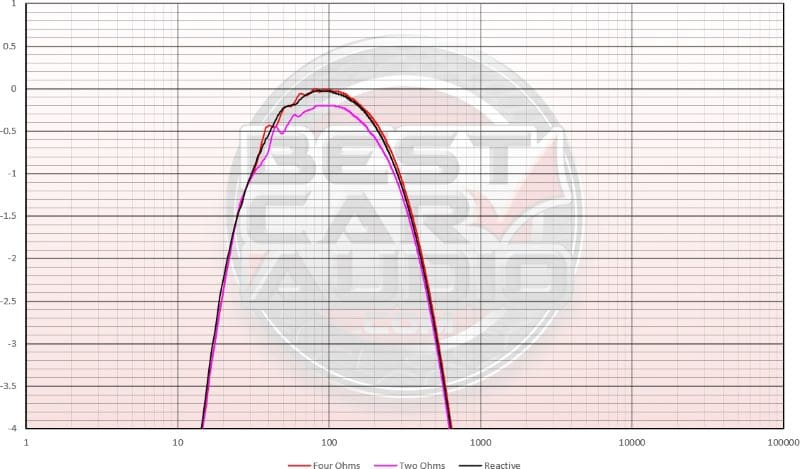
As is typical with Class D amplifiers, the speaker load works as a voltage divider with the amplifier’s output impedance. On the main channels, this resulted in a dip of about 0.4 dB in the upper midrange – all normal and quite acceptable for this type of design. The top-end frequency response was well outside the audible range at 29 kHz with the reactive load. The subwoofer channel offered a bandwidth of 17 hertz to just over 500 hertz with -3 dB tolerances – more than adequate for any system.
Next, I tested the noise and distortion performance of the AF M5.11 bit. The THD+N noise numbers are excellent for a Class D amp at 0.0137% at an output level of 1 watt into a 4-ohm load. That clarity was audible during the listening evaluation. The signal-to-noise ratio performance was excellent for a compact amplifier at just shy of -79 dB. The subwoofer channel performed equally well on both tests.
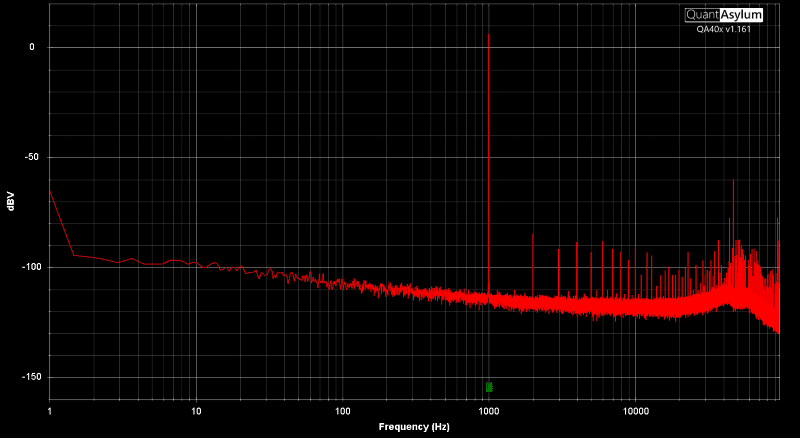
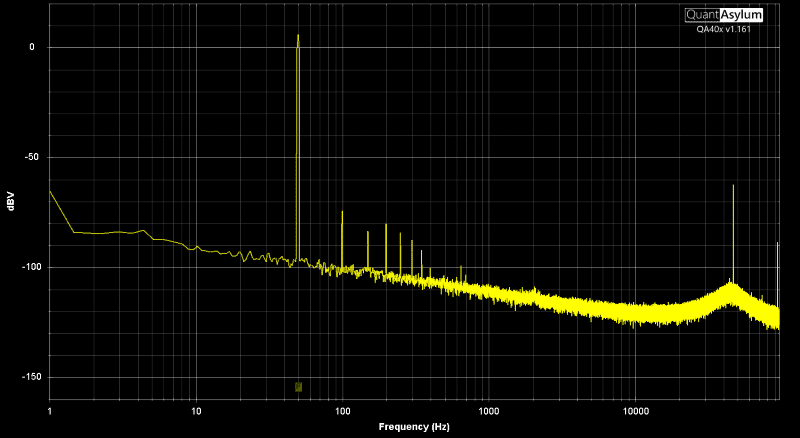
Next, I measured THD+N versus frequency for both the main and the subwoofer channels. Again, the amp behaved well, with nothing of concern showing up. The rise in the distortion on the subwoofer channel at high frequencies is irrelevant, as it won’t produce those signals at any significant amplitude. In short, it’s great where it matters.
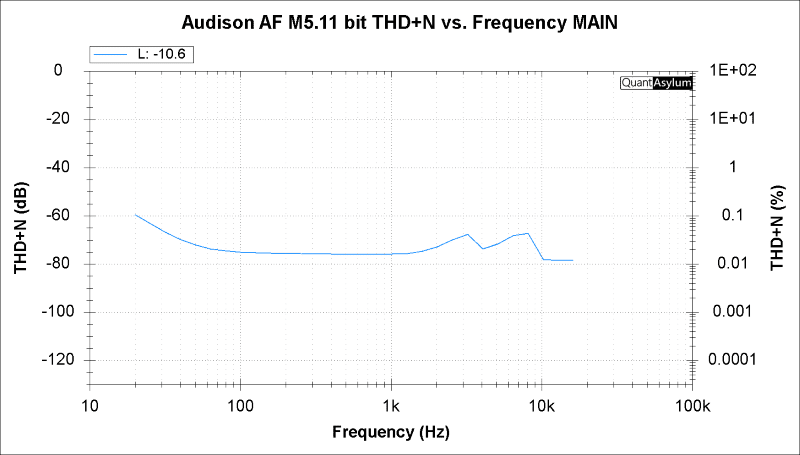
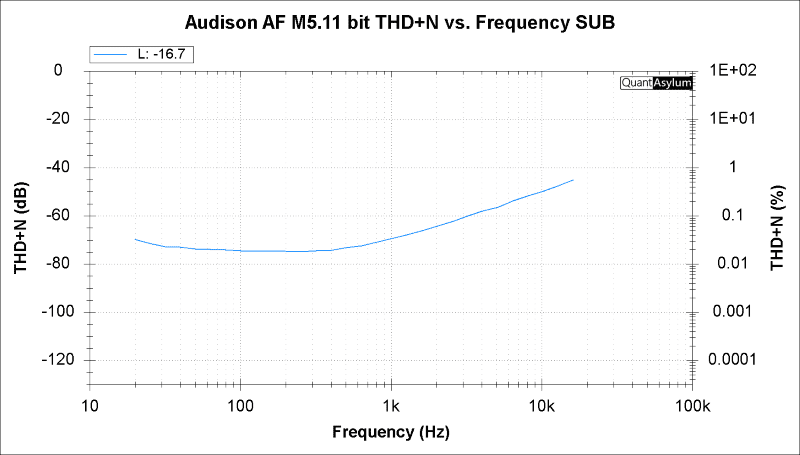
Everything I measured regarding sound quality and noise was in line with Audison’s specifications and impressive for an amplifier as compact as this.
Finally, it was time to get into the power measurements. I started with distortion versus output plots for the main and subwoofer channels to establish how the amp would sound when driven hard versus quietly. Once again, nothing abnormal showed itself in my measurements.
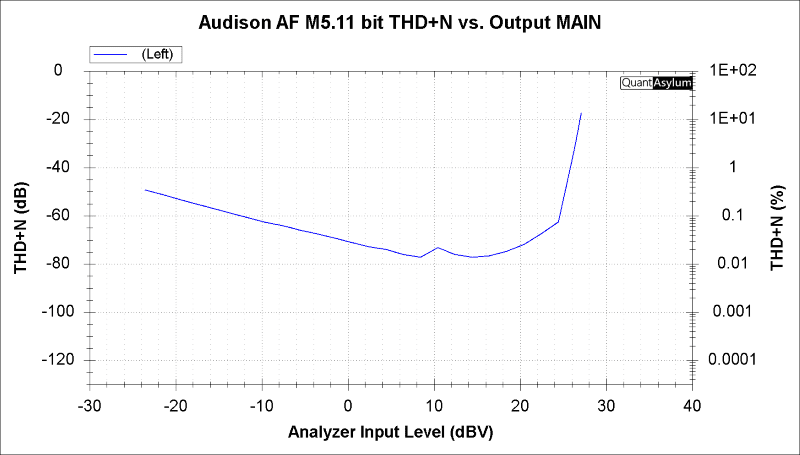
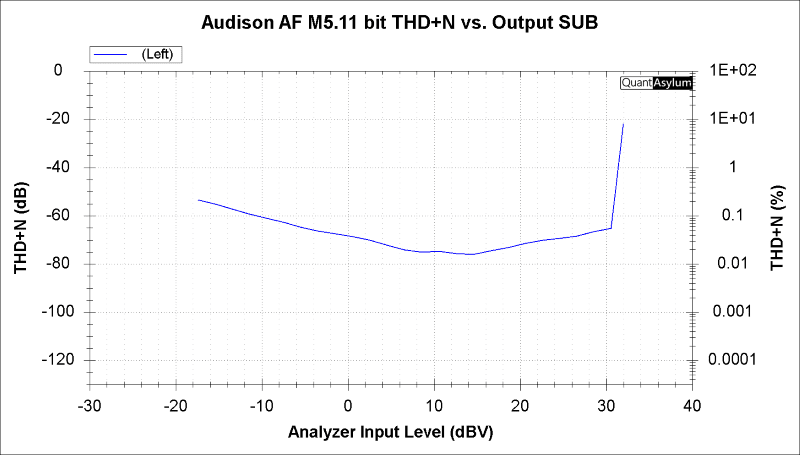
OK, time for the disproportionately important power numbers. First, Audison publishes CTA-2006-C compliant levels and some “normal” power numbers. I’m not sure why they aren’t the same, but that’s OK. Everything aligns well with the 85-watt per channel 4-ohm ratings from the mains and the 340-watt rating from the subwoofer channel. Remember that I don’t test at 14.4 volts, so the measurements would be closer to the provided ratings with more supply voltage. In terms of real-world performance in a vehicle, my numbers are about what you can expect. The maximum power from the amplifier is limited by how much current the supply can deliver, so power production with everything loaded to 2 ohms suffers a tiny bit. Nevertheless, this amp has enough power to get good and loud and make any enthusiast happy. Oh, the amp drew around 85 amps of current with all channels at 2 ohms and the output between 1 and 1.5% THD. The pair of 30-amp fuses pop quickly when you try to do this. You won’t have that problem with music, just test tones – so don’t use this amp in SPL contests with the front channels running.
This amp does a great job of making the most of the power going into it. The efficiency didn’t drop as much as I’d have expected when driving lower impedances. This is an excellent choice in a modern vehicle where all the wiring and alternator are as small as possible!
Conclusions on the Audison AF M5.11 bit Car Audio DSP Amplifier
Many things can go wrong in a compact amplifier design. They can be noisy or overheat easily, and the most popular units on the market don’t sound all that great. I can only imagine how long Audison has been working on these Forza amplifiers, as they’ve addressed those concerns head-on! Noise and distortion performance are very good, and so is efficiency. The heatsink got hot during my power testing, but the heat was well dispersed, so it served its purpose.
Audison’s approach to complex factory-installed audio sources must be commended on the highest levels. Nobody else in the industry is tackling this challenge as aggressively. Other DSP amplifiers have similar integration features, but none has automated processes. We’ll detail those features when I review the Audison bit Tune in the next few weeks.
Ultimately, the Audison AF M5.11 bit sounds excellent, and that matters most to me. So, if you’re looking for a compact amplifier to upgrade the sound system in your car, truck or SUV, drop by a local authorized Audison retailer and ask about the AF M5.11 bit. You can find a retailer near you using the locator on their website. Also, be sure to follow Audison on Facebook, Instagram and YouTube to learn about the new products and solutions from this amazing company.

